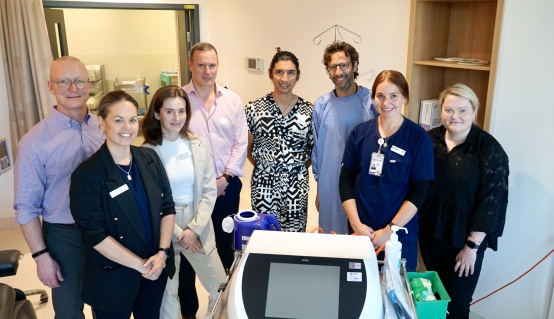Chemo delivered by electric pulses in Australian first
2 min read 17 March 2023
In an Australian first, a Peter Mac patient has had his melanoma zapped with targeted electrical pulses – helping to deliver chemotherapy deep inside cancer cells.

During the procedure on Friday morning - known as electroporation - chemotherapy was injected directly into the tumour on the patient’s head, followed by small electrical pulses delivered by a device that looks like a large pen.
“The electrical pulses make temporary holes in the cell membrane, allowing the drug to penetrate deep inside before the membrane seals off,” Peter Mac’s Dr Hayden Snow, who undertook the procedure said.
“With the chemo inside the cancer cells, they then hopefully start to die back and the tumour will start to shrink over the coming weeks.”
“It’s possible that a single dose is all that’s needed to kill the tumour, but additional treatments can be delivered in the future if required.”

The 20-minute electroporation procedure, done under a local anaesthetic, is a possible alternative to surgery – which would require multiple wounds and skin grafts – and radiation therapy, which would see daily treatments over a number of weeks.
It also delivers the chemotherapy locally, directly to the tumour – rather than it being delivered in a conventional way that affects the whole body.
The patient will likely be left with only a small amount of scar tissue – a far less visible reminder of the cancer versus surgery with a skin graft.
“It’s really exciting to be able to deliver such targeted treatment with minimal impact on the patient – he can head home today and will need very little down time,” Dr Snow added.

Dr Snow was assisted during the procedure by Professor Jim Clover, a consultant plastic surgeon from Cork University Hospital - who is in Australia for the launch of the treatment machine at a melanoma conference next week.
He has seen promising results treating skin cancer cancers in Europe with the technology over the past few years.
“Broad figures are that we would expect four-out-of-five lesions treated to respond, with three-out-of-five responding completely,” Professor Clover says.
“When you compare that to some of the other treatments that are available, they have effectiveness rates of probably half of that. So for targeted areas it’s a really powerful tool.
“And the key thing is to have the biggest toolbox possible when treating skin cancer.”
Health device company Endotherapeutics has brought the technology to Australia and hopes it will “add to the current standard of care” and improve patient experience.
